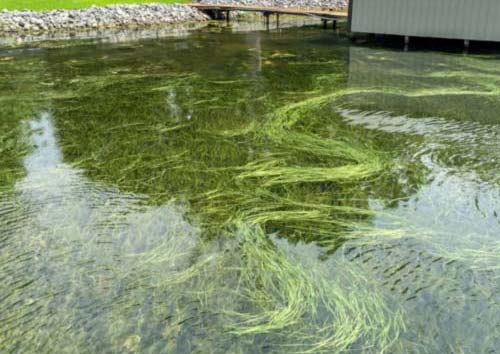Eelgrass, Tapegrass
Unlike some invasive plants, eelgrass (Vallisneria americana) grows vertically without branching, leaving room for fish to congregate among it’s leaves. Use weedless baits to flip into holes or fish a buzzbait just over grass growing a few inches from the surface.

Seasonal Techniques
Spring—Emerging from seeds and overwintering rhizomes, this species is well known for its ability to produce edge habitat in early spring. New, growing shoots provide the perfect fishing scenario in the early spring. Eelgrass often gets a bad rap for being tough to fish a rattle trap through. Fish a swimbait just across the top of emerging eelgrass or work a Carolina rig through and just above actively growing plants.
Summer—Like others, eelgrass begins rapid growth in summer, with it flat, thin ribbon-like leaves growing to the surface and spreading out. Unlike some invasive plants, eelgrass grows vertically without branching, leaving room for water exchange and fish to congregate among it’s leaves. Stay away from treble hooks. Use weedless baits to flip into holes or fish a buzzbait just over grass growing a few inches from the surface.
Fall—Eelgrass has reached peak growth in fall, so fishing may be tough without heavy punch baits. Try to find holes in existing eelgrass or fish the deep edge for a transitional bite.
Winter—Being a perennial, eelgrass can survive through the winter but will reduce itself to small shoots, from which it will begin growing again in spring. Eelgrass may be some of the only grass left in winter, but will have died back to mere clumps. Find these clumps in shallow water and fish with a slow presentation.
Habitat Value
Fish—Eelgrass is prime habitat for fry and juvenile sport fish as well as a refuge for baitfish. The open area among vertical leaves is also the perfect space to ambush predators.
Waterfowl—Leaves, fruits and rootstock are excellent food for waterfowl and can also provide substrate for invertebrates on which some waterfowl species thrive.
Identifying Features
What It Looks Like—Long, ribbon-like leaves make this species easy to identify. During flowering, long curling stalks will be present.
Where to Find It—Initial beds of eelgrass tend to grow in round clumps close to shore and often appear a darker green that other plants at first glance. Existing and well established populations can grow for miles along the river. Look for the tell-tale “waving” of eelgrass as waves pass through its leaves.
Max Depth—0 to 10 feet
Similar Species—This species resembles the early stages of several emergent species including bur-reed, sagitarria and wild rice; however these plants will eventually grow well above the water’s surface, unlike eelgrass.
Drawbacks
Although native, eelgrass has become a nuisance in some areas, impeding swimming, boating and other recreational opportunities. Cost to manage: $$$ out of $$$$$.
Contact Us
We're always looking for more information about aquatic plants on TVA reservoirs. Let us know where and what you see, and send us your photos. Email us.
Guntersville Community Meeting - Dec. 1, 2021
TVA and the Lake Guntersville Stakeholder Group Steering Committee held a virtual community meeting to discuss the eelgrass problem in its reservoirs including Lake Guntersville on Dec. 1, 2021.